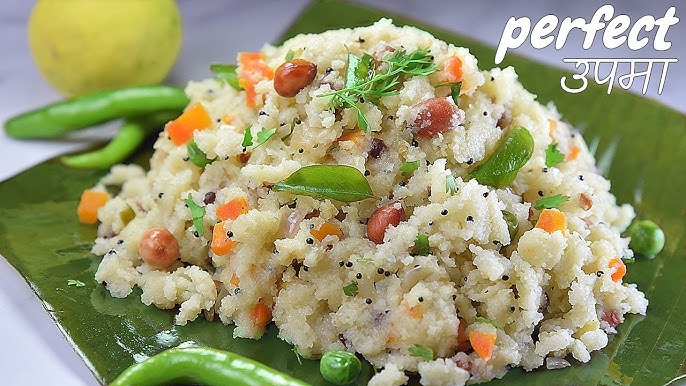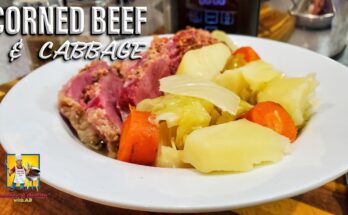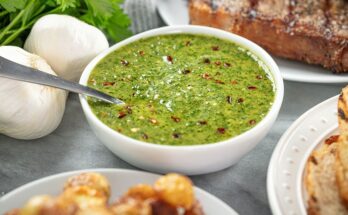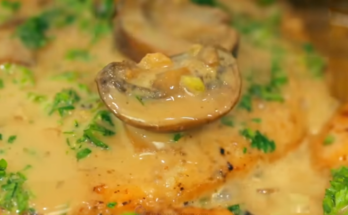Upma Recipe: If there’s one breakfast item that unites millions across India, it’s Upma. This humble yet satisfying dish is a staple in South Indian households and has slowly found its way into the hearts (and kitchens) of people across the country. Whether you’re in the mood for a light breakfast, a quick lunch, or even a dinner fix, upma is versatile, filling, and incredibly easy to prepare.
Let’s dive into this step-by-step guide that’ll help you make soft, fluffy, and delicious upma every single time.
What is Upma?
Upma, also known as uppittu in Kannada or uppumavu in Malayalam, is a savory South Indian porridge made from dry roasted semolina (also called rava or suji). It’s cooked with various seasonings like mustard seeds, curry leaves, green chilies, and sometimes enhanced with vegetables and nuts. The result? A warm, comforting bowl of goodness that pairs beautifully with coconut chutney or even a simple pickle.
What makes upma special is its simplicity. It uses basic pantry ingredients and takes under 20 minutes to make, yet delivers a dish that’s hearty, nutritious, and incredibly adaptable. You can make it vegan, load it with veggies, or keep it minimal—there’s room for experimentation.
Whether you’re a seasoned home cook or a complete beginner, this guide will help you master the art of making perfect upma every time.
Origin and Cultural Significance
The roots of upma go deep into South Indian culinary tradition. Though originally popular in Tamil Nadu, Andhra Pradesh, Kerala, and Karnataka, upma has traveled far beyond its birthplace. Today, it’s a common breakfast and snack item across the Indian subcontinent.
In South Indian households, upma is often served during festivals, fasting days, or even as an offering to deities. It’s economical, easy to prepare for large gatherings, and doesn’t require onion or garlic—making it ideal for religious functions. Over time, regional variants have evolved, including rava upma, rice upma, bread upma, and vermicelli upma.
The cultural charm of upma lies in its flexibility—some like it soft and fluffy, others prefer it a bit coarse and grainy. No matter your preference, it always brings with it a sense of home.
Ingredients Needed for Making Upma
Main Ingredients
To prepare the perfect upma, you only need a handful of readily available ingredients. Here’s a breakdown of the essentials:
- Rava (Semolina/Sooji) – 1 cup (preferably coarse variety)
- Oil or Ghee – 2 tablespoons (for flavor)
- Mustard Seeds – 1 teaspoon
- Urad Dal (Split Black Gram) – 1 teaspoon
- Chana Dal (Bengal Gram) – 1 teaspoon
- Green Chilies – 2 (slit lengthwise)
- Ginger – 1 teaspoon (finely chopped)
- Curry Leaves – 8–10
- Onion – 1 small (finely chopped)
- Salt – to taste
- Water – 2½ cups (or slightly more for softer upma)
Each of these ingredients plays a specific role—semolina is the base, dals provide crunch, and the spices add flavor.
Optional Add-ons and Variations
Want to take your upma up a notch? Try adding these optional ingredients:
- Vegetables – Peas, carrots, beans, corn, and capsicum (finely chopped and pre-cooked or sautéed)
- Cashews – for added richness and crunch
- Grated Coconut – for a mild, sweet touch
- Lemon Juice – adds tanginess and freshness
- Coriander Leaves – for garnish
- Ghee – a spoonful at the end for extra flavor
Depending on your mood or what’s in your fridge, you can transform basic upma into a nutrient-rich power meal with just a few additions.
Kitchen Tools You’ll Need
You don’t need a fancy setup to make upma. Here are the essential kitchen tools:
- Heavy-bottomed Pan or Kadai – prevents the semolina from sticking or burning
- Wooden or Silicone Spatula – for continuous stirring
- Measuring Cups and Spoons – to get your ratios right
- Small Bowl – for holding pre-measured spices
- Knife and Chopping Board – for prepping your veggies and herbs
While you could technically make upma with any pot, using a thick-bottomed pan ensures even cooking and helps avoid that burnt taste at the bottom. Trust me, that’s not how you want to start your day!
Step-by-Step Guide to Making Perfect Upma
Let’s get to the heart of the matter. Follow these steps, and you’ll be serving up a flawless plate of upma in no time.
Step 1: Roasting the Rava (Semolina)
Start with dry roasting your rava in a heavy-bottomed pan over medium heat. Keep stirring it continuously until it turns light golden and gives off a nutty aroma. This step is crucial—it prevents lumps and gives your upma that desirable fluffy texture.
Don’t rush this. Take your time and stir gently for 4–5 minutes. Once roasted, transfer it to a plate and let it cool while you prep the rest of the ingredients.
Roasting ensures that your rava doesn’t become sticky or gooey when water is added. If you skip this step, you risk ending up with clumpy, undercooked upma.
Step 2: Preparing the Tempering
Now, let’s infuse some flavor into that roasted rava. In the same pan, heat 2 tablespoons of oil (or ghee for extra richness). Add 1 teaspoon mustard seeds and let them splutter. Immediately add urad dal and chana dal, and sauté them until they turn golden brown.
Next, toss in the chopped green chilies, finely chopped ginger, and curry leaves. Sauté this mix for a minute or so until the raw aroma fades. Add the chopped onions and sauté until they turn translucent.
This tempering is what gives upma its characteristic flavor and a lovely bite. The crunch of dal, the heat from chilies, and the zing from ginger—each element plays a part. If you’re adding cashews, now’s the time to roast them in the pan as well.
Tempering isn’t just a step—it’s the soul of the dish.
Step 3: Adding Vegetables (Optional but Recommended)
Though traditional upma is made without vegetables, adding them not only enhances the nutrition but also makes it more visually appealing and satisfying.
You can add vegetables like chopped carrots, green beans, green peas, sweet corn, or even finely diced bell peppers. Make sure they’re cut small and evenly so they cook quickly. Once your tempering is ready, toss the vegetables into the pan and sauté for 3–4 minutes.
If you’re in a hurry, use frozen mixed vegetables—they cook faster and save chopping time. Add a pinch of salt at this stage to speed up the softening process.
Cover the pan with a lid and cook for a couple of minutes until the vegetables turn tender. Stir occasionally to avoid burning.
Adding veggies not only adds color and crunch but also gives your upma a balanced blend of carbs, fiber, and essential nutrients. Perfect if you’re trying to eat clean without compromising on taste!
Step 4: Boiling Water and Cooking the Rava
This is the most crucial part of the process. For 1 cup of rava, boil 2½ cups of water in the same pan where the tempering and veggies are ready. Add salt to taste at this stage—usually about ¾ teaspoon for every cup of rava.
Once the water starts boiling, lower the flame and begin adding the roasted rava slowly, using one hand to pour and the other to stir continuously. This technique ensures that the semolina mixes evenly and prevents any lump formation.
Stirring continuously is essential. If you pause, you risk lumps forming, and no one wants a lumpy upma! After all the rava is in, cover the pan and cook on a low flame for 3–4 minutes.
You’ll see the water getting absorbed, and the rava will swell up, turning soft and fluffy. Once the water is completely absorbed, turn off the flame and let the upma sit, covered, for another 3 minutes. This resting time allows the flavors to meld and the texture to perfect itself.
Step 5: Final Touches and Garnishing
Now comes the finishing touch that elevates your upma from good to great. Add a teaspoon of ghee (if you haven’t used it already) to give it a silky texture and delicious aroma. Toss in a handful of freshly chopped coriander leaves and squeeze in some lemon juice to brighten the flavors.
Stir gently to mix everything. Serve hot with coconut chutney, pickle, or just enjoy it on its own. A steaming bowl of garnished upma is a comfort food that can turn any rushed morning into a pleasant one.
If you want to serve it restaurant-style, consider adding a sprinkle of grated coconut or a few fried cashews on top for that extra oomph!
Tips for Making Soft and Fluffy Upma
Achieving the perfect consistency in upma is an art. Here are some pro tips that will help you nail it every time:
- Roast the Rava Properly – Don’t skip or rush this. Even a lightly roasted rava can absorb water unevenly and become sticky.
- Use Hot Water – Always add hot boiling water to the pan. Cold water will shock the rava and create lumps.
- Maintain the Water Ratio – For softer upma, use 2½ to 3 cups of water per 1 cup of rava. For a firmer texture, reduce water slightly.
- Stir Constantly While Adding Rava – Prevents lump formation and ensures even cooking.
- Rest After Cooking – Letting the upma sit covered for a few minutes after cooking enhances the texture and flavor.
A little patience and precision go a long way in making perfect upma.
Common Mistakes to Avoid While Making Upma
Even though upma is one of the simplest Indian dishes to cook, there are a few common pitfalls that can ruin its texture or taste. Let’s break down the usual suspects and how you can avoid them:
1. Skipping the Roasting Step
This is a rookie mistake. Unroasted rava will clump together when water is added, resulting in a sticky mess rather than a fluffy, soft upma. Always roast your rava until it emits a light aroma and turns slightly golden.
2. Incorrect Water Ratio
Too much water makes your upma soggy; too little will make it dry and undercooked. The ideal ratio is 1 cup of rava to 2½ cups of water. Adjust slightly based on the type of rava and how soft or firm you want your upma.
3. Adding Rava Too Quickly
Pouring rava all at once into the water is a surefire way to get lumps. You need to pour the rava in a steady stream while stirring continuously. This distributes the grains evenly and prevents clumping.
4. Not Stirring Enough
During the initial few minutes after adding rava to boiling water, constant stirring is key. It keeps the mixture from sticking to the bottom and avoids uneven cooking.
5. Not Letting it Sit
After the cooking is done, covering and letting the upma rest for a few minutes makes a big difference. It allows the moisture to distribute evenly and the texture to settle beautifully.
Avoid these errors, and your upma will go from average to amazing.
Nutritional Value of Upma
Upma isn’t just tasty—it’s also a nutritional powerhouse, especially when made with the right ingredients. Let’s break down the nutritional profile of a standard serving of vegetable upma (1 bowl or approx. 150 grams):
| Nutrient | Approximate Value |
|---|---|
| Calories | 180–220 kcal |
| Carbohydrates | 30–35 grams |
| Protein | 4–5 grams |
| Fat | 5–7 grams |
| Fiber | 3–4 grams |
| Sodium | Depends on added salt |
| Vitamin A/C | Present (from veggies) |
| Iron & Calcium | Present |
Health Benefits
- Low in Calories: Great for those looking to maintain or reduce weight.
- Rich in Fiber: Keeps your digestive system happy.
- Provides Energy: The carbs in rava give you a good energy boost.
- Easy to Digest: Suitable for all age groups, including toddlers and elders.
- Customizable: You can boost the nutrition by adding protein-rich dals or nuts and fiber-rich veggies.
It’s clear that upma, especially with vegetables, is a well-balanced meal that doesn’t compromise on taste or health.
Best Side Dishes to Serve with Upma
While upma is quite satisfying on its own, pairing it with the right side dish can take your meal to the next level. Here are a few popular accompaniments:
1. Coconut Chutney
This is the classic combo. The cool, nutty flavors of coconut chutney balance the warm, savory taste of upma. Add green chilies and roasted chana dal for a richer taste.
2. Tomato Chutney
A tangy and spicy tomato chutney adds a kick to your upma. It’s especially great if you like bold flavors.
3. Pickle (Achar)
Indian pickles—mango, lemon, or mixed—are a spicy and sour addition that contrasts beautifully with the soft texture of upma.
4. Yogurt
Plain curd or spiced buttermilk can be served on the side. It’s a cooling complement and aids digestion too.
5. Banana or Sugar (Traditional Style)
Some traditional households serve upma with slices of banana or a sprinkle of sugar. It may sound unusual, but the sweet-salty combo is surprisingly delightful!
Whatever you pair it with, upma is incredibly versatile and fits well into various meal plans and preferences.
Storage and Reheating Tips
Made a big batch of upma or planning for leftovers? Here’s how to store and reheat it the right way:
Storing Upma
- Refrigerate: Let the upma cool completely before storing. Transfer it to an airtight container and place it in the fridge. It stays fresh for up to 2 days.
- Freezing: Not ideal. Semolina can become grainy when thawed and reheated, affecting the texture.
Reheating Upma
- Microwave Method: Sprinkle a little water over the upma before microwaving to restore moisture. Cover it with a lid or microwave-safe plate and heat for 1–2 minutes.
- Stovetop Method: Heat a pan with a few teaspoons of water or ghee. Add the upma and stir gently until heated through. Cover with a lid to steam it lightly.
Make sure not to overcook it while reheating—it can dry out quickly. Add a dash of lemon juice or fresh herbs to revive its flavor.
FAQs about Upma Recipe
1. What is Upma made of?
Upma is typically made from semolina (rava or suji), cooked with water, sautéed vegetables, and tempered spices like mustard seeds, curry leaves, and green chilies.
2. Is Upma healthy?
Yes, Upma is a healthy and nutritious breakfast option. It’s low in fat, high in fiber (especially if you add vegetables), and keeps you full for longer.
3. Can I make Upma without vegetables?
Absolutely! Plain Upma without vegetables is traditional and still flavorful. However, adding veggies boosts its nutritional value and texture.
4. How do I prevent Upma from becoming lumpy?
Roast the semolina well and add it gradually to boiling water while stirring constantly. This prevents lumps and ensures a smooth texture.
5. Can I use other grains instead of semolina?
Yes! You can use millets, oats, or broken wheat as healthier alternatives. Each brings its own taste and texture to the dish.
6. Is Upma gluten-free?
Traditional Upma made with semolina is not gluten-free. However, using gluten-free grains like rice rava or quinoa can make it suitable for gluten-intolerant individuals.
7. How long does it take to cook Upma?
Upma is a quick dish — it usually takes 10 to 15 minutes from start to finish, making it perfect for busy mornings.
8. Can I store leftover Upma?
Yes, store leftovers in an airtight container in the fridge for up to 2 days. Reheat with a splash of water to regain its soft texture.
Conclusion
Upma might look like a simple dish, but its beauty lies in that simplicity. It’s quick, nutritious, incredibly customizable, and oh-so-comforting. With just a few pantry staples and a little bit of care, you can create a wholesome meal that suits any time of the day. Whether you’re cooking for yourself, feeding your family, or impressing guests, this step-by-step guide ensures you get it right every single time.
So the next time you’re looking for a warm, fulfilling, and easy meal, don’t look too far—make yourself a bowl of classic upma!



